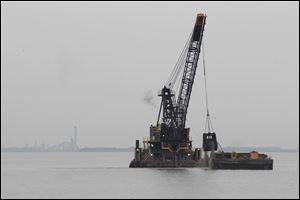
Army Corps of Engineers dredging plan draws sharp rebuke from Toledo residents
3/29/2018Though only two years away from a state-imposed deadline to stop open-lake disposal of dredged material, the U.S. Army Corps of Engineers is proceeding as usual this summer with plans to put just as much silt as it normally digs out of the Toledo shipping channel into the open water of western Lake Erie’s North Maumee Bay.
That massive volume comes to 800,000 cubic yards again. The Corps, which maintains its dredging operations are environmentally safe, has dredged 800,000 to 1.2 million cubic yards of silt from the shipping channel each summer for years to keep it deep enough for cargo ships to ply shallow Toledo-area water.

A crane on a barge dredges Lake Erie near the Toledo shipping channel in 2015. A plan by the U.S. Army Corps of Engineers to dump dredged material into open water in western Lake Erie’s North Maumee Bay has met with resistance from some.
That’s enough dirt to fill Toledo’s tallest skyscraper three times.
Toledo is the Great Lakes region’s most heavily dredged shipping channel, being the region’s shallowest. The Corps needs to dredge silt to keep the shipping channel open. That much has never been under dispute. But the controversy over where to get rid of the muck has raged since the federal agency began dumping it back into the water in the mid-1980s, just a few miles from where the digging occurs.
Fish biologists claim the swirling sediment impacts spawning in the Great Lakes region’s most sensitive — yet productive — area for fish reproduction. They and other experts continually question whether the displaced, nutrient-enriched sediment — most of which enters the Maumee River after being blown off or trickling off farms between Toledo and Fort Wayne, Ind. — is to some degree a contributor to western Lake Erie’s chronic algae problem. The controversy continues, despite a Corps-funded report a few years ago that claims there is no such correlation.
Under Senate Bill 1, a 2015 law that Ohio Sen. Randy Gardner (R., Bowling Green) co-sponsored and Gov. John Kasich signed in response to the algae-induced Toledo water crisis of 2014 that temporarily fouled the city’s tap water, the Corps is to end open-lake silt disposal in Ohio by July 1, 2020. That law, though, allows for an unlimited number of annual exemptions for Toledo because of its heavy volume.
On Thursday night, the Ohio Environmental Protection Agency took comments on the Corps’ 2018 dredging plan, which is focused this year on about 166 acres in the lake approach channel in Maumee Bay, northeast of downtown and beyond the Maumee River.
Dredging is prohibited before July 1, so as not to interfere with the river’s annual walleye run and the spawning season.
Only about 10 people attended this year’s annual hearing, held inside Toledo City Council Chambers.
Several expressed their continued frustrations with the situation.
Terry Shankland, Partners for Clean Streams president, acknowledged that dredging is only “a small part of our green water problem,” but he said he’s grown weary trying to get the state of Ohio to play hardball with the Corps.
“All we’re doing is rearranging the chairs on the deck of the Titanic,” Mr. Shankland said, telling agency reps the Ohio EPA needs to stand up against the Corps.
Records, though, show the Ohio EPA has tried to do that on several occasions but had its get-tough attempts overturned by Ohio’s Environmental Review Appeals Commission, the only state board empowered to overturn state EPA decisions.
Several years ago, former Ohio EPA Director Chris Jones issued a five-year permit that required a 20 percent reduction in open-lake disposal each year. His goal was to make the Corps phase out the practice before the next permit was issued. The Corps got ERAC to overturn that decision.
Less than a month before the 2014 water crisis, Mr. Kasich and Ohio EPA Director Craig Butler staged a photo-op along the Maumee River to announce a pilot project in North Toledo’s Riverside Park, where the feasibility of using dredged material to grow crops would be studied. That project is still being developed.
Written comments on the 2018 dredging plan are being accepted by the Ohio EPA until next Thursday.
Contact Tom Henry at thenry@theblade.com, 419-724-6079, or via Twitter @ecowriterohio.